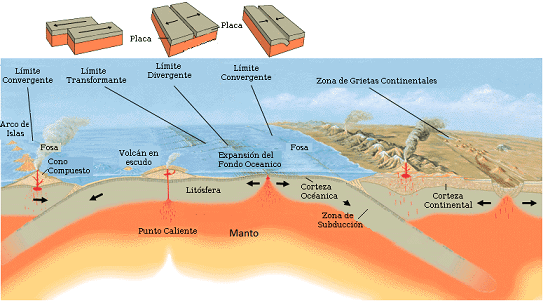Structure of the earth's crust
The Earth's crust is the outermost and thinnest layer of the Earth, and is in contact with the atmosphere and the hydrosphere.
The earth's crust is made up of thin materials, such as light silicates, carbonates, and oxides.
Geologically, the earth's crust is a very active layer, since two types of geological processes take place:
- Internal geological processes: Volcanoes , earthquakes, etc., that create relief.
- External geological processes: The energy from the Sun and gravity cause erosion, transport and sedimentation to act, which tend to destroy the relief.
There are two types of earth's crust:
Continental crust
The continental crust has the following characteristics:
- It is made up of rocks of varied composition, although sedimentary rocks tend to predominate in the most superficial part, metamorphic rocks in the deepest areas, and there are also igneous rock outcrops.
- Its thickness is greater than that of the oceanic crust, having an average thickness of about 33 km, although it is greater in areas with orogens, and can reach up to the 75 km thickness that it has in the Himalayas.
- The continental crust can be as old as 3.8 billion years.
- The continental crust is the one found on the continents (in their mountains, valleys, plateaus, etc.) and on the continental shelf (an area near the coast of not too deep, covered by sea water).
Ocean crust
The main characteristics of the oceanic crust are:
- The oceanic crust is thinner than the continental crust. It varies between 6 and 12 km, with an average thickness of 7 km.
- The structure of the oceanic crust is divided into three levels:
- Lower level: Formed by gabbros, some basic plutonic rocks.
- Intermediate level: Formed by basalts, some basic volcanic rocks.
- Upper level: Formed by marine and continental sediments (near the coast).
- Although most of the oceanic crust is under the sea, there are exceptions like Iceland, which are above sea level in the mid-ocean ridges.
- The oceanic lithosphere, formed by the oceanic crust and part of the upper mantle, is generated in the oceanic ridges and disappears, descending towards the mantle, in the oceanic trenches. That's why the oldest ocean rocks are only 180 million years old.
- The oceanic crust is characterized by its great abyssal plains of the seabed in which the oceanic ridges, guyots (seamounts) and oceanic trenches stand out.
